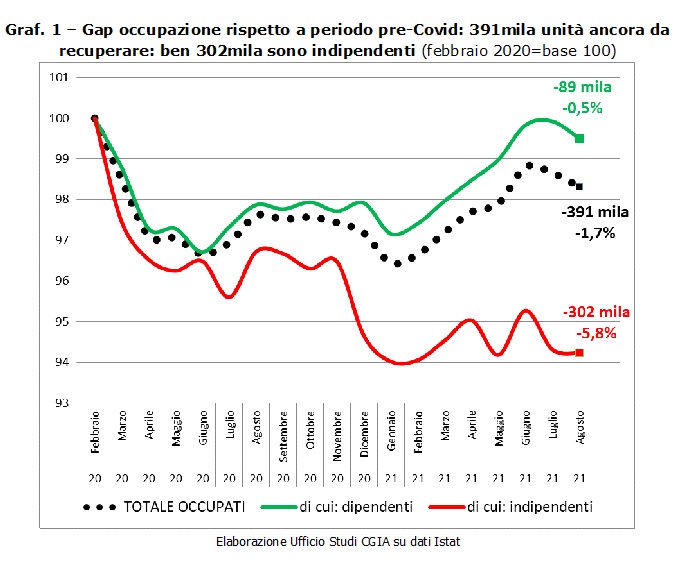From February 2020, the month before Covid, to last August, the latest available survey, the total number of self-employed workers fell by 302 units (-5,8 percent). In the same period, however, employees decreased by 89 thousand (-0,5 per cent). If, in absolute terms, the former fell below the threshold of 5 million (precisely 4.936.000), the latter reached 17.847.000.
In short, in a year and a half Covid has put a strain on the Italian world of work, even if the so-called people of VAT numbers have paid the consequences. He was denounced by the CGIA Studies Office.
• The causes of this death
To the traditional problems that have always plagued micro enterprises (taxes, bureaucracy, lack of credit, etc.), the closures imposed by decree, the limitations on mobility, the collapse of household consumption and the boom in e-commerce recorded in this last year and a half have worsened the situation of many self-employed who have been forced to permanently close their business. These micro realities, we recall, live almost exclusively on internal demand, linked to the territory in which they operate. In 2020 alone, household consumption in Italy fell by about 130 billion euros, money that largely fueled the revenues of the very small businesses that, following this contraction, were no longer able to make ends meet.
• Without shops, cities are no longer the same
Walking along the historic centers and in the districts of both large cities and small suburban towns, the number of artisan shops and small commercial shops with the shutters constantly lowered and the lights inside completely off is increasing sharply. Less visible to the naked eye, but equally worrying, are the closures that have also affected freelancers, lawyers, accountants and consultants who carried out their activities in offices / studios located within a condominium. In short, cities are changing face: with fewer shops and offices they are less frequented, more insecure and with increasing levels of degradation.
• Immediately a crisis table on self-employment
For months the CGIA has been asking both Premier Draghi and the governors to open a permanent crisis table at national and local level. In fact, as never before, it is necessary to give an answer to a world, the autonomous one, which is experiencing a particularly delicate situation. Mind you, there are no miraculous measures. And we must not forget that in this last year and a half, in addition to the refreshments (although completely insufficient), the successive executives have, among other things, approved the ISCRO, extended the use of the universal allowance for dependent children also for the self-employed and emergency income has been introduced for those who are still in business. All important measures, but not sufficient to stem the difficulties that have emerged in these months of pandemic.
• More business in schools
It is also necessary to involve the Ministry of Education so that it activates as soon as possible an important information / training action towards high school students that makes them aware of one point in particular; once school is over, one can also establish oneself as self-employed workers in the labor market. This latter perspective is little known among young people. It is also desirable, where these experiences do not exist, to open moments of confrontation between the social partners (employers' associations and trade unions), local institutions (Municipalities, Provinces, CCIAA, etc.) and the world of school with the aim of bring demand as close as possible to the job offer. A problem, that of the employment mismatch, which paradoxically also affects those areas of the country that have very high levels of youth unemployment.
• Statistics of the self-employed
The crisis in the world of self-employment starts a long time ago. In the last 17 years, the maximum peak of openings was reached in March 2004, when the total number of independents present in Italy reached 6.303.000 units. Subsequently, there was a continuous "bleeding" which in December 2020 brought this category of employment below the threshold of 5 million. In January of this year, however, the lowest quota since this time series has been reached was reached: 4.925.000. Finally, from February, the climb that lasted until April resumed. Subsequently, the curve had a sinusoidal trend and stopped in August at an altitude of 4.936.000.
• Employee numbers
If, as we said above, in these 18 months of pandemic we have lost "only" 89 thousand employees, it should still be noted that in absolute terms the holders of a permanent contract have suffered a more marked reduction than that recorded by temporary workers. . In fact, between February 2020 and August 2021, the former recorded a contraction of 57 units (-0,4 percent), while the latter, on the other hand, suffered a decrease of 32 (-1,1 percent).



